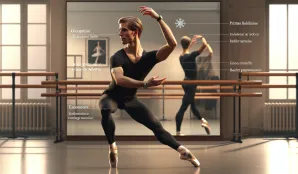- Salary statistics
- Prima ballerina
Prima ballerina
41 395 - 39 779 kr / month
Kultur, media, design
Salary progression Prima ballerina
What does a prima ballerina do? – Job tasks and working environment
A prima ballerina is a leading female dancer within ballet, often the principal performer in productions. Tasks include performing technically advanced and artistically expressive ballet performances, often with high demands on precision and physical endurance. The roles require intensive training, rehearsals, and collaboration with choreographers, directors, and other dancers. The working environment is usually a stage or rehearsal studio focused on artistic performance and physically demanding work.
Salary development over time
The average salary for prima ballerinas has shown positive growth over the past three years. In 2022, the average salary was 32,600 SEK per month, which increased to 39 614 SEK in 2023 and further to 39 779 SEK in 2024. This represents an increase of over 21 percent from 2022 to 2024. This salary development can be explained by increased demand for high-quality dance performances and increasingly specialized ballet education. The high physical and artistic competence of prima ballerinas means that salary levels reflect the demanding nature and prestige of the profession. At the same time, hourly wages for part-time workers are about 239 SEK, indicating good compensation even for part-time work within the profession.
Prima ballerinas often need to combine extreme physical strength with emotional expressiveness, making the profession unique in the arts world.
Prima ballerina salary – complete overview
- Average salary: 39 779 SEK/month
- Lowest/highest salary: Specific levels are not available
- Hourly wage: 239 SEK/hour (based on 166 working hours/month)
- Gender differences: No specific data available
- Regional differences: Data not available
Education and qualifications
The path to becoming a prima ballerina is long and requires specialized ballet training, often starting at a young age. Formal education is complemented by practice and intensive training to develop technique, stage presence, and artistic ability.
- Formal qualifications: Ballet training at dance schools or art colleges, often 3–5 years
- Certifications/courses: Specialized dance courses in classical ballet and stage performance
- Internships/trainee programs: Often internships or trainee programs at professional ballet companies
- Prerequisites: Early start in dance and good physical condition
- Tips for choosing: Select programs with strong links to professional dance companies
Common benefits and compensations
Prima ballerinas can often expect benefits such as wellness allowances, health insurance, and opportunities for further training. Compensation may include travel and accommodation costs during tours, as well as bonuses related to performances. Employment is often contract-based with various social benefits depending on the employer.
Competition and challenges
The profession of a prima ballerina is highly competitive, with few reaching the highest level. Physical injuries and high demands on endurance are common challenges. The role also requires discipline and continuous development of technique and expression. Competition for leading roles is intense, and careers are often shorter than in many other professions due to physical strain.
Tips for aspiring prima ballerinas
To succeed as a prima ballerina, it is good to combine strong discipline with passion for dance and expressiveness. Developing patience is crucial since training and success require long-term effort. Good physical condition and body control are necessary to meet technical demands, and continuous work on technique is important. Collaboration and social skills facilitate interaction with choreographers and fellow dancers, which is central to professional performances. Lastly, having a creative mindset is vital for interpreting roles in a personal and artistic way.
Key facts about prima ballerinas
- Average salary: 39 779 SEK/month
- Hourly wage: 239 SEK/hour
- Education level: Specialized ballet training, 3–5 years
- Work environment: Stage and rehearsal spaces with high physical demands
- Occupational group: Choreographers and dancers
Career paths and future prospects
After 3–5 years as a prima ballerina, opportunities include developing into a choreographer, ballet teacher, or artistic director within dance companies. The profession is part of a broader occupational group with 620 available jobs according to the Swedish Public Employment Service, but specific forecasts for prima ballerinas are lacking due to limited data. The occupational group is characterized by a combination of creativity and technical skill, making it possible to find roles within culture and media beyond the stage. Future prospects are considered stable, but competition remains high.
Frequently asked questions about prima ballerinas
- What does a prima ballerina earn?
- The average salary is approximately 39 779 SEK per month, with an hourly wage of about 239 SEK. - What education is required to become a prima ballerina?
- A specialized ballet education at a dance school or art college, often 3–5 years, is common. - What is the working environment like for a prima ballerina?
- The working environment is physically demanding with a lot of time on stage and in rehearsal studios. - Are there gender differences in salary for prima ballerinas?
- Specific data on gender differences is lacking. - How is the competition within the profession?
- The competition is very high as few reach the position of prima ballerina. - What career opportunities exist after being a prima ballerina?
- Opportunities include becoming a choreographer, ballet teacher, or artistic director within dance companies.
Salary distributed by age and sector
About the data
All information displayed on this page is based on data from the Swedish Central Bureau of Statistics (SCB), the Swedish Tax Agency and the Swedish employment agency. Learn more about our data and data sources here.
All figures are gross salaries, meaning salaries before tax. The average salary, or mean salary, is calculated by adding up the total salary for all individuals within the profession and dividing it by the number of individuals. For specific job categories, we have also considered various criteria such as experience and education.
Profession Prima ballerina has the SSYK code 2653, which we use to match against the SCB database to obtain the latest salary statistics.






